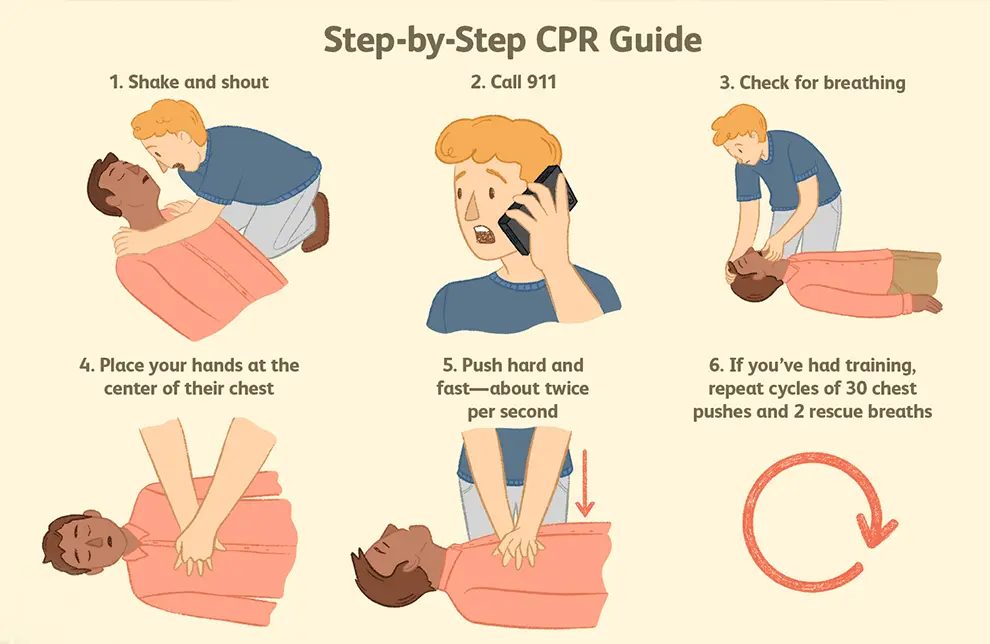
What is CPR?
CPR, or cardiopulmonary resuscitation, is a critical emergency technique employed when a person's heart ceases to beat effectively. This state, known as cardiac arrest, arises from severe arrhythmia, hindering the heart's ability to pump blood adequately
Death can swiftly follow if immediate life-saving measures aren't administered. During CPR, chest compressions manually circulate blood essential for delivering oxygen throughout the body
According to the CDC, when CPR is initiated within the first few minutes of cardiac arrest, it can significantly improve survival rates, potentially doubling or even tripling a person's chances of recovery. This underscores the vital importance of CPR as a life-saving technique during emergencies.
You can think of the steps in CPR in order by remembering CAB:
C is for chest compressions.
A is for opening a person’s airway.
B is for giving them rescue breaths.
How should I prepare for CPR?
Before starting CPR, follow these steps:
Assess the Situation: If you witness someone collapsing, immediately check their responsiveness by asking loudly if they're okay. If there's no response, proceed to the next steps.
Call for Help: Dial 911 or ask someone nearby to call for emergency medical assistance. Inform the dispatcher of the situation and follow their instructions until paramedics arrive.
Ensure Safety: Before approaching the individual, Ensure that both you and the victim are safe from harm.
Retrieve an AED: If available, request someone nearby to fetch an automated external defibrillator (AED). These devices can significantly increase the chances of survival by restoring the heart's normal rhythm.
Assess Breathing: Tilt the person's head back gently while they lie on their back. Lean in close to their face and listen for any sounds of breathing for about 10 seconds.
Check for Signs of Life: Observe the person's chest to see if it is rising and falling, indicating breathing. Additionally, check for a pulse by feeling the side of their neck.
Perform CPR if you don’t feel a pulse.
How to perform CPR?
The procedures for CPR vary depending on the age of the victim , Here's an overview of CPR guidelines according to the American Heart Association:
CPR for Adults and Older Children (8 years and above):
- Place one hand on the center of the person's chest just below the nipples.
- Place the other hand on top, interlocking your fingers.
- Use your body weight to compress the chest hard and fast, aiming for a depth of about 2 inches.
- Keep your arms straight and compress at a rate of 100 to 120 beats per minute, to the rhythm of songs like "Staying Alive" or "Crazy in Love."
- If trained, alternate between 30 chest compressions and 2 rescue breaths. If not trained, continue chest compressions only.
- Rotate with another person if available, and continue until emergency medical help arrives or the person revives.
CPR for Children (1 to 8 years):
- Place one hand in the center of the child's chest on the breastbone.
- Use your body weight to compress the chest to a depth of about 2 inches.
- Maintain a compression rate of 100 to 120 beats per minute.
- If trained, alternate between 30 chest compressions and 2 rescue breaths. If not trained, continue chest compressions only.
- Continue until emergency medical help arrives or the child revives.
CPR for Infants (Up to 1 year):
- Check for responsiveness by flicking the bottom of the infant's foot.
- If unresponsive and not breathing or showing signs of a heartbeat, place two fingers in the center of the infant's chest.
- Firmly compress the chest to a depth of about 1-1/2 inches at a rate of approximately 120 beats per minute.
- If trained, alternate between 30 chest compressions and 2 rescue breaths. If not trained, continue chest compressions only.
- Continue until emergency medical help arrives or the infant revives.
After first responders take over caring for the person receiving CPR, they’ll get them to a hospital as soon as possible.
In conclusion, the importance of immediate CPR cannot be overstated. It has the potential to double the chances of survival. By empowering more people with this life-saving skill, we can significantly reduce the number of preventable deaths due to cardiac arrest and create safer communities for all.